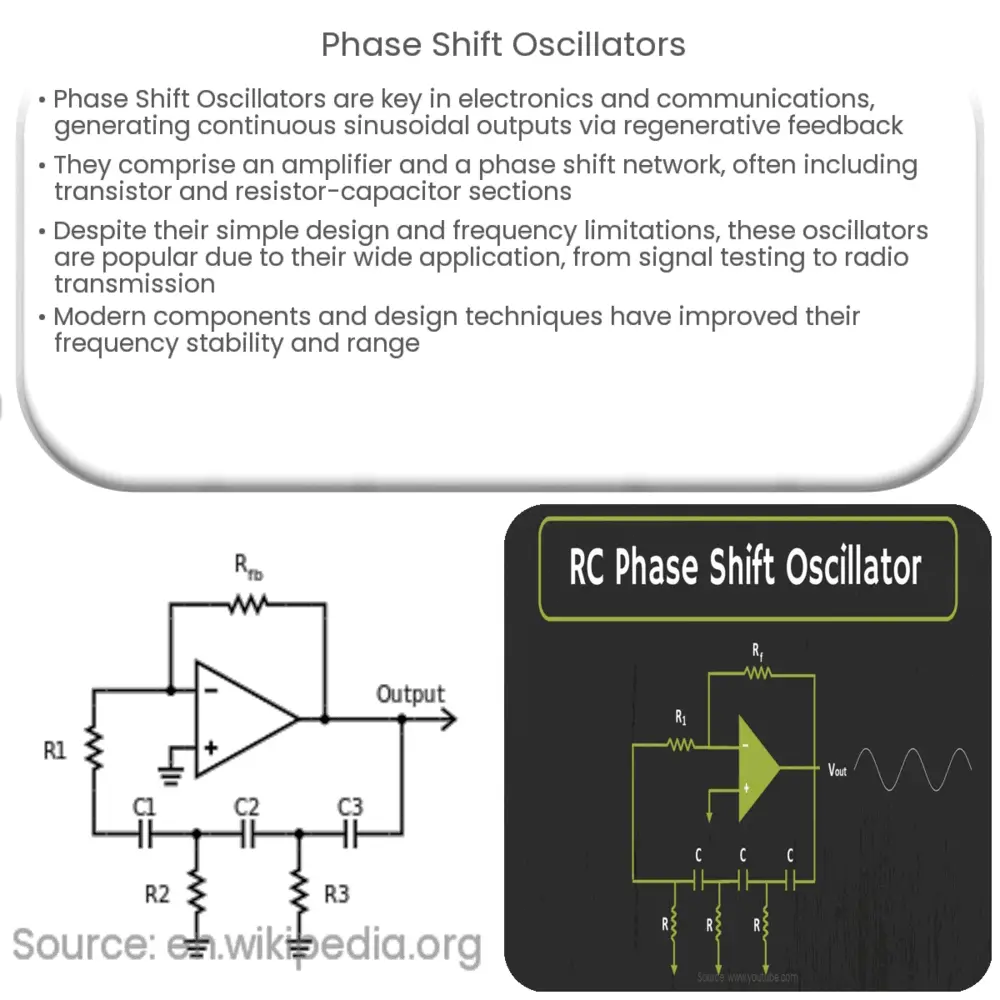Explore the world of Phase Shift Oscillators: their operation, design, advantages, challenges, and recent advancements in electronics.

Introduction to Phase Shift Oscillators
Phase Shift Oscillators are a type of oscillator that are critical in the field of electronics and communications. An oscillator, in general, is a circuit which produces a continuous, repeated, alternating waveform without any input, and a phase shift oscillator is a specific type of these circuits that generates a sinusoidal output.
Principle of Operation
Phase Shift Oscillators operate on the principle of regenerative feedback. In these oscillators, a phase shift network, typically made up of resistors and capacitors, introduces a phase shift to the signal. The oscillator is designed in such a way that the total phase shift around the loop is 360 degrees or 0 degrees, which is a constructive interference condition that allows for continuous oscillation. The amplifier in the feedback loop compensates for the losses in the phase shift network and maintains the amplitude of the oscillations.
Structure and Components
The typical structure of a Phase Shift Oscillator includes an amplifier and a phase shift network. The amplifier is often a transistor, either BJT (Bipolar Junction Transistor) or FET (Field Effect Transistor), though operational amplifiers (op-amp) can also be used. The phase shift network, on the other hand, usually includes three resistor-capacitor (RC) sections.
Advantages and Applications
Phase Shift Oscillators are known for their simplicity and ease of design. They are used in a wide range of applications, thanks to their capacity to generate sinusoidal outputs without any input signal. They are often utilized in signal generation and testing in laboratories, audio frequency generation, and in some cases, as a part of more complex electronic circuits, such as in radio receivers and transmitters.
The RC Phase Shift Network
The resistor-capacitor (RC) phase shift network is a key element of these oscillators. It comprises three RC sections, each providing a phase shift of up to 60 degrees at the desired frequency. When the phase shifts from all sections are combined, they give a total phase shift of 180 degrees. The other 180 degrees are provided by the amplifier, bringing the total to the necessary 360 degrees for sustained oscillation.
The Amplifier
The amplifier plays a vital role in a Phase Shift Oscillator circuit. Not only does it provide the necessary gain to compensate for the losses in the RC network, but it also introduces an additional 180 degrees of phase shift. For an oscillator to sustain, the loop gain must be equal to or greater than one, and the total phase shift around the loop must be 360 degrees. Thus, the amplifier has a dual role to play.
Design Considerations
Designing a Phase Shift Oscillator requires careful consideration. The values of the resistors and capacitors in the phase shift network must be chosen such that the network contributes a phase shift of 180 degrees at the desired frequency of oscillation. Similarly, the amplifier must be designed to provide sufficient gain to compensate for the losses in the RC network and maintain the amplitude of oscillations.
Challenges and Limitations
While Phase Shift Oscillators are simple in design, they are not without their challenges and limitations. The main challenge in the design of these oscillators is to achieve the necessary phase shift and gain conditions at the desired frequency of oscillation. Furthermore, these oscillators may suffer from frequency stability issues due to changes in the values of the resistors and capacitors with temperature. Additionally, the frequency of oscillation is relatively low compared to other types of oscillators.
Recent Advances
Recent advances in Phase Shift Oscillator design have addressed some of these challenges. For example, the use of modern components such as operational amplifiers and digital signal processors has improved the frequency stability and range of these oscillators. Furthermore, the use of advanced design techniques and simulation tools has made it easier to design and optimize these oscillators for specific applications.
Conclusion
In conclusion, Phase Shift Oscillators are a fundamental component in the field of electronics and communication. They operate on the principle of regenerative feedback, and their design involves an amplifier and a phase shift network. Despite the challenges in their design and limitations in frequency stability and range, their simplicity and ease of design make them a popular choice for various applications. As advancements continue to be made, we can expect to see improved designs and wider applications for these versatile electronic devices.

